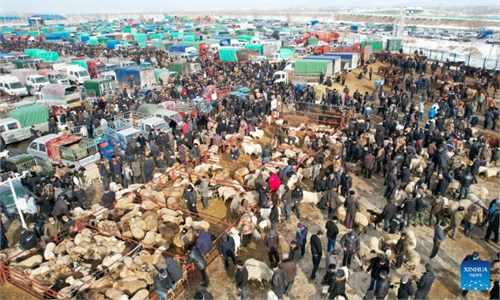GT on the spot: Khunjerab Port linking China and Pakistan emerges from pandemic, looking forward to greater growth in 2023
Gateway linking western China with southern, central Asia set to expand

A truck enters the customs inspection area of the Khunjerab Port on February 7, 2023. Photo: Liu Caiyu/GT
Driving along the China-Pakistan Friendship Road in the Taxkorgan Tajik Autonomous County in Northwest China's Xinjiang region, a fleet of trucks carrying walnuts, groceries and auto parts slowly pulled out of Khunjerab Port one by one, and entered Pakistan.
It is the second temporary opening of Khunjerab Port this year at Pakistan's request to facilitate customs clearance for supplies. And it's the only land port linking China and Pakistan.
In the three years since COVID-19 erupted in 2020, Khunjerab Port, like all other land crossings in China on the forefront of guarding against imported COVID-19 cases, shut down its passenger pass entirely. The Port opened for occasional emergency cargo transportation.
"But this time, cross-border drivers can drive their truck heading to Pakistan directly, unlike during the epidemic when they had to leave their cargo in designated areas after rounds of disinfection, with the Pakistani side coming to pick them up the following day," Zhang Xiaobo, the customs director at the Khunjerab Port, said.
The customs clearance processes have resumed to pre-COVID settings. As the region's epidemic situation stabilizes, the passenger crossing service is projected to resume when the port fully opens in April, Zhang noted. China downgraded its managementof COVID-19 from Class A to Class B as of January 8.
"I was very happy and relieved when I drove my truck off to Pakistan this time. I don't need to wear masks that make breathing difficult in such high-altitude, and wear protection suits that enveloped my entire body in," said cross-border freight driver Wang Chuanhai.
This year the 54-year-old driver has already twice passed the snow-capped port to Sost Dry Port in Pakistan's Gilgit-Baltistan region during temporary openings. The current temporary opening will last 12 days between January 30 and February 10. The first port opening was between January 19 and 20.
The two temporary openings have facilitated 128 cross-border personnel visits, 328 transportation vehicles' passes, and more than 6,000 tons of goods exported.
The freight volume, at a standstill for the past three years, will bottom out and rebound, and the record high of 100,000 tons of freight volume is expected to be achieved this year. Improved momentum lies ahead in the post-epidemic era as China and Pakistan continue to deepen the construction of the China-Pakistan Economic Corridor (CPEC).
Compensatory growth
"We expect to witness a huge compensatory growth of cross-border trade and transportation in this year at the Khunjerab Port," Ye Hailin, deputy director-general at National Institute of International Strategy of the Chinese Academy of Social Sciences (CASS), told the Global Times.
The port saw more than 200 vehicles throughout 2021, and in 2022 the port dispatched around 600 vehicles worth of cargo, but in 2023 since the grand reopening, a total of 5,000 vehicles worth of goods are expected to be delivered to neighboring countries through the port, said Wang Shicheng, the general manger of a logistic company in Kashi.
During the two periods of temporary opening, Wang Shicheng sent more than 30 trucks loaded with groceries, auto parts, polyester cloth and clothing from the port into Pakistan.
"We've suffered 30 million yuan ($4.41 million) in losses over the past three years because of the epidemic, but after China downgraded its COVID-19 management, I'm confident we will win back our losses soon, likely within the next year and a half," said Wang Shicheng, owner of more than 130 cross-border trucks.
Because of cold weather and thin air, Khunjerab Port, seated on mountains of altitudes of 5,000 meters, generally opens from April 1 to November 30 every year, and remains closed from December 1 to March 31.
Wang Shicheng declined many phone calls when talking with Global Times reporters. Though there is about two months before Khunjerab Port fully opens in April, logistic orders from Kyrgyzstan, Tajikistan and Pakistan have filled up Wang Shicheng's daily schedule. Many of his foreign customers cannot wait to pass the border for trade and business and strike a deal in-person, rather than making orders online as they were doing during the epidemic.
Making Khunjerab Port a year-long operation has been one of the targets for the region in 2023, the Global Times learnt from a foreign affairs office in Kashi prefecture. If the initiative is approved, it is expected to drive cross-border trade and business.
Bigger role ahead
People passing by always would like to pose for a photograph with a huge board reads "Long Live China-Pakistan Friendship" in front of the outpost of exit/entry border checkpoint at the Khunjerab Port.
Doing business with Pakistan is a source of pride for drivers, businessmen and officials from both sides. Driver Wang Chuanhai cannot cover his joy when recalled of how he was welcomed by Pakistani people with milk tea when he drove there.
"Pakistani people are really friendly to Chinese. We don't have to worry about experiencing unexpected emergency there. When we're in difficulty, they always reach out to help. Once Pakistani security forces protected us to deliver the cargo to Karachi, and three patrolling planes watched from the sky." Wang Shicheng said doing business with Pakistan makes him proud.
Wang Shicheng is confident over an increase in his business in the post-epidemic era, especially now that cold-chain warehouses backed with 80 million yuan in investment by Taxkorgan Tajik Autonomous County are completed.
Now seafood from the Indian Ocean can be imported directly from Pakistan, something unimaginable a few years ago, same as Buffalo embryos, forage grass, and fresh fruits like mango and cheery, Jiang Wenjie, a customs officer said when he talked with Global Times reporters in front of the gateway of China at the port.
The cargo volume between China and Pakistan at Khunjerab Port peaked at 83,000 tons in 2017. Though under the epidemic in 2022, the Khunjerab Port achieved a substantial increase in cargo clearance, a total of 22,600 tons of goods were exported that year, an increase of 358.9 percent over 2021.
The freight volume, at a standstill for three years, will soon rebound, and the record high of 100,000 tons of freight volume is expected to be achieved this year, according to Zhang, the customs director at the Khunjerab Port.
Not only serving as a border for entering and exiting China and Pakistan, the Khunjerab Port also receives travelers from other countries, with generally at least 15,000 people coming from more than 30 countries and regions passing through each year, Jiang noted.
Though being China's westernmost and highest port in the world, the pass is able to deliver cargo from provinces across the country to neighboring countries in hours. Wang Shicheng's trucks are loaded with groceries from East China's Zhejiang Province, agricultural products from Xinjiang, induction heaters from South China's Guangdong Province and mechanical equipment from East China's Jiangsu Province.
"It's role as a gateway linking western China together with South Asian and Central Asian countries could only become bigger in the coming years, Now the China-Pakistan railway is being planned and Tashkurgan Khunjerab airport - China's westernmost airport and the first Xinjiang airport of ultra-high altitude - has officially opened to traffic, I see no reason to stop Khunjerab Port from continuing to open up," Jiang said.
Counsellor of the State Council and economist Justin Lin Yifu, who paid a visit to the Port on Tuesday, holds the same opinion. He told the Global Times that "Khunjerab Port has a good momentum of development in all aspects, including infrastructure, and with the development of China's economy and the further construction of the CPEC, the port can play an increasingly important role."
Khunjerab Port as the only land port between China-Pakistan is irreplaceable as the CPEC continues to deepen, Ye from the CASS noted. But many obstacles lie ahead for the port to realize full potential.
Being extremely cold and located at high altitude is one of apparent natural factors that impede border trade. Neighboring areas of the two countries at the pass are both economically underdeveloped areas and it is very difficult for such places to carry out border port trade, Ye said. Cases of cross-border drivers suffering from altitude sickness are not rare, the Global Times learnt.
The throughput of Suster Port in Pakistan was designed to be as much as 100,000 tons, and the mechanization and automation of cargo handling was low, which resulted in the backlog of vehicles and goods to a certain extent. The cargo clearance capacity at the Port could further improve if the hardware infrastructure construction of the Pakistani side could develop accordingly as the CPEC continues to advance, Jiang said.




